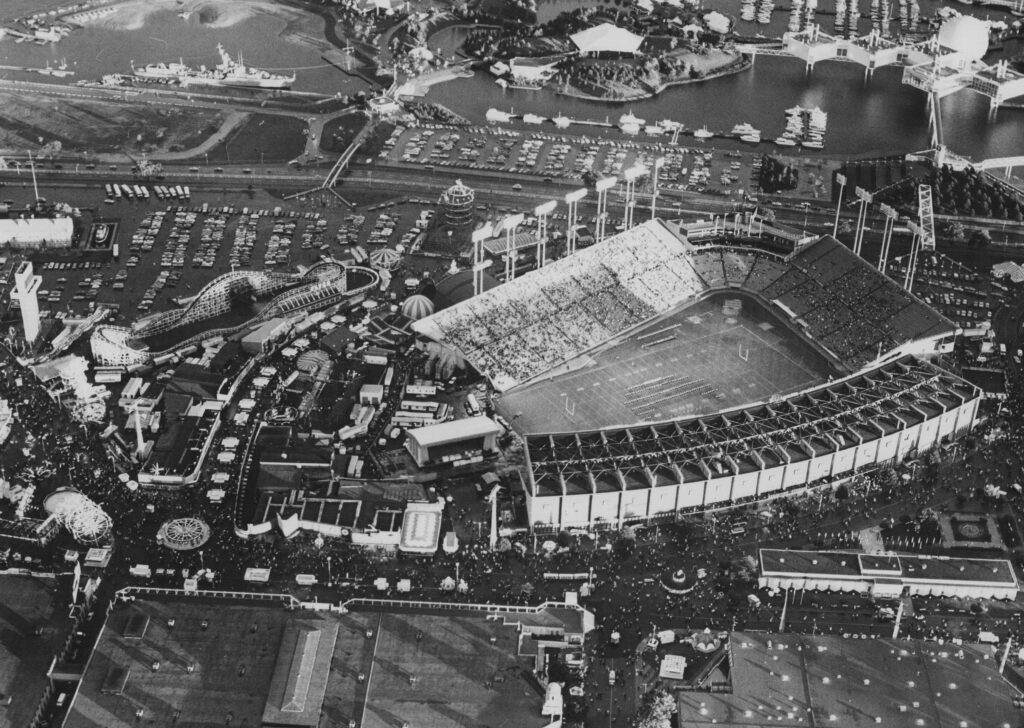An aerial photograph of the 1977 Canadian National Exhibition catches the scale of one man’s legacy and an entire industry in transition. At the top sits Ontario Place, the provincially owned entertainment venue built on a series of artificial islands that was as contested back then as it is now. In the middle is the imposing Exhibition Stadium, steadily expanded since 1948. While not yet at full capacity, its bleachers are filling — drawing tens of thousands of those fairgoers from the midway to the east. And what a midway it is, arguably the world’s finest. Close to a whirling Round‑Up, supposedly the champagne of rides, spin three Ferris wheels in a row. Nearby is one of five masts holding up the Alpine Way, a 2,100-foot cable-car ride permanently suspended 100 feet in the air. On the viewer’s far left stands the iconic Shell Oil Tower. Sunnyside, where a small affiliated amusement park geared toward children once operated throughout the summer months, is just out of frame on the viewer’s right. And dominating the midway — in pride of place — sprawls the Flyer, for a time the tallest and fastest roller coaster anywhere, which had carried more than five million passengers over the preceding quarter century. It was this coaster, a wooden centrepiece anchoring the largest annual fair in Canada and beyond, that epitomized the influence of Patty Conklin, a one-of-a-kind impresario and carnie king. Twenty years after the photograph was snapped, most of these structures would be demolished, just as Conklin’s legacy started to slip away.

Opening day of the Canadian National Exhibition, in Toronto, on August 17, 1977.
Don Dutton, 1977; Getty
James Wesley “Patty” Conklin Jr. came from a different world than mid-century Toronto — and with a different name. He was born in Brooklyn in 1892 and raised in Paterson, New Jersey, by his relatively impoverished German immigrant parents. Back then he was called Joseph Renker, but he started to reinvent himself around 1906, when he ran away from home to find his way on the streets of New York or, depending on which version of the story he was sharing later in life, Jersey City. In most accounts, he quickly established a profitable scam outside the old Madison Square Garden, hawking peanuts and somehow making up to $26 an hour. He also sold papers on elevated railway platforms for a spell, this being the era of enterprising newsies. All the while, he witnessed the creation of Times Square and watched as vaudeville theatres and nickelodeons sprang up around it. By 1912, maybe even in time for the first Calgary Stampede, he’d left New York full of ideas and entered a peculiarly North American industry still in its infancy: the carnival.
It didn’t take long before Renker fell in with James W. Conklin and his wife, Ella, who spent their winters in New Orleans. The two carnies effectively adopted the young man, who assumed J. W.’s name, his Irish heritage, and, upon his death in 1920, his modest road show. By the time of Patty’s own death fifty years later, he had built that show into a bona fide empire.
John Thurston himself used to work the midway, and with Carnie King: The Story of Patty Conklin and Conklin Shows, he filters an impressive amount of primary research through his own experience in an earlier time. This is an author who knows first-hand the meaning of “nut” (the overhead expense of an individual ride) and “flash” (those alluring prizes that attract would‑be players to a game booth). While partially a biography of Patty Conklin, Thurston’s book is also a family history — especially of the son and grandson who followed the titular hero into the business — and a richly detailed account of the twentieth-century carnival trade in Canada, the United States, and occasionally parts of the Caribbean.
Because the Canadian National Exhibition was for so long the premier annual fair in the world, and because it was the most coveted jewel in Patty’s crown, much of the book unfolds in Toronto and nearby Brantford, where Conklin Shows kept equipment in the off-season and where Patty kept tabs on his expanding domain. But Carnie King also roams widely, touching down in places big and small, from Quebec City to Victoria, from The Pas to Tampa.
There is an absorbing interconnectedness that pulses through Thurston’s chronicle. Convincingly, he situates the carnival generally and Conklin Shows specifically within a broader sweep of North American culture. Patty and his associates were innovators. It was their idea, quite obvious in retrospect, to pave dirt and gravel lots around the country — so that travelling midways operating on the thinnest of margins could still make money after it rained. They responded to the popularity of comic books and motion pictures, to shifting political and social mores, to tax policies and urban planning decisions, to unpredictable weather patterns and recessions, to major wars and rocket ships, to the Seattle World’s Fair and Expo 67, to the emergence of shopping malls and major grocery chains, and to the creation of Disneyland and its many imitators (Patty claimed to have sold Walt his first merry‑go-round). All the while, Conklin Shows, under its various guises, embraced an ersatz Canadianness when convenient and downplayed it when not.
The year that aerial photograph was taken, the Conklins welcomed some sixteen million people onto their roaming rides across the continent, mostly between late spring and early autumn. Compare that with the two million people they entertained just a decade earlier or the 10.9 million people who visited Disneyland, open year-round, in 1977. Without question, this was a thriving realm.
As Thurston explains, however, it would soon begin to dwindle, the victim of politicking in Toronto’s city hall, of the 1979 energy crisis, of soaring insurance costs, and of the Conklins’ own ambitions. Eventually, they were too big not to fail. By the mid-’90s, the CNE had somewhat unceremoniously said goodbye to its famous roller coaster, its cable car, its penny arcade, its permanent concessions hall (all built and paid for by Patty), and then its crowd-generating stadium. Air-conditioned convention space and corporate sponsorships would take their place. Elsewhere, smaller regional fairs began to disappear or sign up less expensive carnivals. Conklin Shows struggled to service the debt that it had assumed as it expanded beyond its founder’s wildest dreams. What remained of the kingdom was acquired in October 2004 by a new corporate conglomerate, North American Midway Entertainment. Today the old company’s once ubiquitous Conko the Clown logo (designed by Chris Yaneff, who also branded Air Canada and Via Rail) is largely relegated to two stands at the CNE selling ice cream waffles, “a confection that was but one of the firsts Patty brought to the public at his annual world’s fair.”
Reading about Joe Renker’s transformation into Patty Conklin brings to mind any number of showmen who similarly reinvented themselves or found their own way, from Buffalo Bill Cody to Charlie Chaplin. And reading about his early days on the carnival circuit brings to mind Buster Keaton’s evolution from a vaudeville prodigy to Hollywood royalty.
Unlike Buster Keaton, though, Patty Conklin had a star that, while temporarily eclipsed on occasion, just kept rising and rising during his lifetime. When he died in 1970, at seventy-eight, from a chronic hematologic condition possibly related to the hours he spent in his poorly ventilated winter maintenance shop with cigarette in hand, he was a beloved legend. His eighteen honorary pallbearers included Ontario’s lieutenant-governor, and the province made an exception to allow his funeral procession, all 150 cars, to drive down the Queen Elizabeth Way. “Patty built his show by pilfering a patrimony from an ailing widow,” Thurston writes. “By the time he died he was a respectable businessman.”
The story of that metamorphosis is undeniably fascinating, though it’s one that Thurston too often tells in the most excruciating fashion. Indeed, the innumerable itineraries, admissions figures, and equipment purchases and sales that he includes can make for tedious going. The length of his eleven chapters — forty pages on average — is also punishing. The downside of Carnie King is not in its colourful characters, historical analysis, or contemporary relevance, but in the interminable waiting for the action or telling anecdote. Like an overstuffed midway, it is exciting but also frustrating.
What Thurston has accomplished for those with patience is admirable. In that sense, his book resembles a day spent standing in line for roller coasters. Reasonable people will quickly give up and go do something else. Enthusiasts who don’t will be thrilled when they’ve ridden the last ride. And as they finally make their way home, they’ll mostly recall the magic.
Kyle Wyatt is the editor of the Literary Review of Canada.

